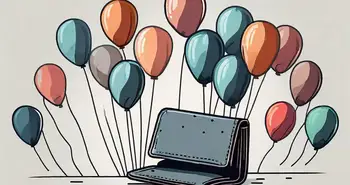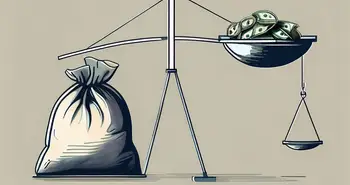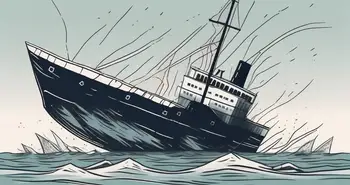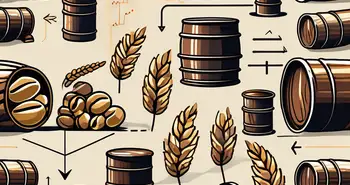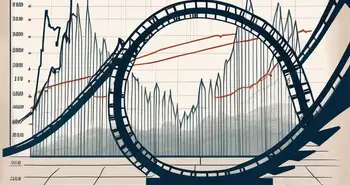What Defines a Recession, and What are Its Implications for the Economy?

In today's fast-paced and interconnected world, the state of the economy is a topic of paramount importance. One aspect that often garners attention is the occurrence of recessions. But what exactly is a recession, and what implications does it have for the economy? Allow me, as an expert in economics, to guide you through this subject and shed light on the intricacies involved.
Understanding the Concept of a Recession
When it comes to understanding recessions, it's crucial to begin with a clear definition of this economic phenomenon. Simply put, a recession is a significant decline in economic activity, spanning multiple sectors of the economy for an extended period, usually two consecutive quarters. It involves a conspicuous deceleration in various key indicators, such as production, employment, and income. Recessions are not confined to any single country; they can spread globally, as witnessed during the infamous financial crisis of 2008.
During a recession, the effects are felt by individuals, businesses, and governments alike. As economic activity slows down, businesses often face declining revenues and profits, leading to cost-cutting measures such as layoffs and reduced investments. Individuals may experience job losses, reduced income, and increased financial insecurity. Governments, in response to the economic downturn, may implement fiscal and monetary policies to stimulate economic growth and mitigate the negative impacts of the recession.
The Economic Definition of a Recession
According to the traditional economic definition, a recession starts when there is a decline in real gross domestic product (GDP) for two consecutive quarters. GDP is a comprehensive measure of an economy's output, encompassing goods and services produced within a specific period. When this measure contracts for an extended period, it signals a pronounced slowdown in economic growth and a potential recession.
However, it is important to note that the definition of a recession is not solely based on GDP contraction. Economists also consider other factors, such as changes in employment levels, consumer spending patterns, and business investment. These additional indicators provide a more nuanced understanding of the overall economic health and help in identifying the onset of a recession.
Key Indicators of a Recession
While the GDP contraction is a vital criterion, it is only one piece of the puzzle. In addition to this primary indicator, economists closely analyze other crucial factors that contribute to the identification and understanding of a recession. Some of these indicators include unemployment rates, industrial production, consumer spending, and business investment. By examining these indicators collectively, economists gain a comprehensive view of the current economic climate and the potential onset of a recession.
Unemployment rates play a significant role in determining the severity of a recession. As businesses face declining demand and reduced revenues, they often resort to workforce reductions to cut costs. This leads to higher unemployment rates and increased financial strain on individuals and families. Moreover, the impact of unemployment extends beyond the immediate loss of income, as it can also result in reduced consumer spending and further contraction of the economy.
Industrial production is another crucial indicator that economists closely monitor during a recession. A decline in industrial production signifies reduced manufacturing activity, which can have far-reaching implications for the overall economy. Industries such as automotive, construction, and manufacturing are particularly vulnerable during a recession, as they heavily rely on consumer demand and business investments. A slowdown in industrial production can lead to factory closures, layoffs, and a ripple effect throughout the supply chain.
Consumer spending, often referred to as the backbone of the economy, is a key indicator of economic health. During a recession, individuals tend to cut back on discretionary spending and focus on essential goods and services. This reduction in consumer spending can further exacerbate the economic downturn, as businesses face reduced demand and struggle to maintain profitability. Understanding consumer behavior and spending patterns is crucial for policymakers and businesses alike, as it provides insights into the overall economic sentiment and potential recovery prospects.
Business investment, including capital expenditures and research and development, is another vital indicator of economic activity. During a recession, businesses often adopt a cautious approach and reduce their investment plans. This can have long-term implications for innovation, productivity, and economic growth. Understanding the dynamics of business investment is essential for policymakers, as it helps in designing strategies to encourage investment and stimulate economic recovery.
In conclusion, while the definition of a recession is based on the decline in real GDP for two consecutive quarters, economists consider a range of indicators to gain a comprehensive understanding of this economic phenomenon. Unemployment rates, industrial production, consumer spending, and business investment are among the key indicators that provide insights into the severity and potential recovery prospects of a recession. By analyzing these indicators collectively, policymakers and economists can develop strategies to mitigate the negative impacts of a recession and foster economic growth.
The Causes of a Recession
Recessions are not random occurrences; they are often driven by underlying causes. To comprehend their nature, we must delve into the roots of these economic downturns.
The Role of Economic Cycles
Economic cycles play a prominent role in the occurrence of recessions. These cycles consist of alternating periods of expansion and contraction, with recessions marking the end of an expansionary phase. Initially, during the expansion phase, economic activity is vibrant, accompanied by rising employment, income, and spending. However, as economic growth reaches its peak, imbalances and vulnerabilities emerge, leading to an eventual correction and subsequent recession.
During an economic expansion, businesses experience increased demand for their products and services. This demand, in turn, leads to higher production levels and job creation. As employment rates rise, individuals have more disposable income, which fuels consumer spending. The increased spending further stimulates economic growth, creating a positive feedback loop.
However, as the expansionary phase progresses, certain imbalances start to emerge. For example, excessive borrowing and lending may occur, leading to a buildup of debt. Additionally, asset prices, such as housing or stock prices, may become overinflated, creating a potential bubble. These imbalances can create vulnerabilities within the economy, making it susceptible to a correction.
When the economy reaches its peak, these imbalances become unsustainable, and a correction takes place. This correction often manifests as a recession, with a decline in economic activity, job losses, and a decrease in consumer spending. The correction serves to rebalance the economy and correct the excesses that had built up during the expansion phase.
Impact of Financial Crises
Financial crises can also precipitate or exacerbate recessions. These crises may stem from various factors, such as the bursting of asset bubbles or the collapse of financial institutions. The consequences of financial crises can ripple across the economy, triggering a downward spiral of reduced consumer and investor confidence, tightened credit conditions, and a contraction in economic activity.
When a financial crisis occurs, it can have far-reaching effects on the economy. For example, if an asset bubble bursts, such as the housing market crash in 2008, it can lead to a significant decline in housing prices. This decline not only affects homeowners who may face negative equity, but it also impacts financial institutions that hold mortgage-backed securities. As the value of these assets plummets, banks may face insolvency, leading to a credit crunch.
A credit crunch occurs when banks become reluctant to lend money, tightening credit conditions. This reduction in available credit can have a detrimental effect on businesses and individuals alike. Businesses may struggle to secure loans for investment or to meet their operational needs, leading to a decline in investment and job losses. Individuals may find it challenging to obtain credit for major purchases, such as homes or cars, further dampening economic activity.
Moreover, financial crises can severely impact consumer and investor confidence. When individuals witness the collapse of financial institutions or the erosion of their savings, they become more cautious with their spending and investment decisions. This decrease in consumer spending and investment can further exacerbate the economic downturn, prolonging the recessionary period.
In conclusion, recessions are complex phenomena with various underlying causes. Economic cycles and financial crises both play significant roles in the occurrence of recessions. Understanding these causes can provide insights into the nature of economic downturns and help policymakers and individuals navigate through challenging times.
The Stages of a Recession
Recessions are not singular events but rather unfold over several stages. By understanding these stages, we can gain insights into the mechanisms that underpin a recession.
From Expansion to Peak
During the expansion phase of the economic cycle, there is a steady upswing in various economic indicators. Employment levels rise, consumer spending increases, and businesses flourish. This period often culminates in an economic peak, signifying the zenith of the expansionary phase. However, it is at this juncture that vulnerabilities accumulate, ultimately leading to the onset of a recession.
The Downward Slide to Trough
Following the peak, the economy embarks on a downward slide, transitioning into a recession. As economic activity contracts, businesses face declining demand and lower revenues. Consequently, companies may resort to cost-cutting measures, including layoffs and reduced investment. These actions further dampen economic activity, perpetuating the downward spiral. The trough denotes the lowest point of the recession, from which the economy gradually begins to recover.
The Implications of a Recession for the Economy
The ramifications of a recession extend far beyond mere numbers and graphs. They permeate various aspects of the economy, leaving a profound impact on businesses, industries, employment, and wages.
Effects on Businesses and Industries
During a recession, businesses across industries face a challenging landscape. Reduced consumer spending leads to declining revenues and potential losses. To navigate these turbulent times, companies often resort to cost-cutting measures, such as layoffs, reduced production, and consolidated operations. Unfortunately, some businesses may even face closure, as the harsh economic climate becomes insurmountable. Thus, a recession serves as a litmus test for the resilience and adaptability of businesses.
Impact on Employment and Wages
Employment and wages bear the brunt of a recession, as economic contraction stifles job creation and reduces business profitability. Companies faced with declining revenues and uncertain future prospects often resort to layoffs or hiring freezes. The increasing supply of jobseekers outweighs demands, leading to a rise in unemployment rates. Furthermore, those fortunate enough to retain their jobs may encounter stagnant wages or reduced working hours, exacerbating the strain on individuals and their families.
Government Response to a Recession
When confronted with a recession, governments and central banks wield an arsenal of policy tools to mitigate its impact and facilitate economic recovery.
Monetary Policy Adjustments
Central banks play a crucial role during a recession by implementing monetary policy adjustments. They may resort to reducing interest rates to stimulate borrowing and investment, thereby boosting economic activity. Additionally, central banks may engage in quantitative easing, which involves injecting liquidity into the financial system to alleviate credit constraints and promote lending. These measures aim to stimulate the economy and facilitate a swift recovery.
Fiscal Policy Measures
Governments can also utilize fiscal policy measures to counteract the detrimental effects of a recession. They may implement stimulus packages, increasing government spending or cutting taxes to stimulate consumer spending and business activity. By injecting additional funds into the economy, governments hope to create a virtuous cycle of increased demand, job creation, and economic recovery.
Now that we have explored the nature of recessions and their implications for the economy, let me share a personal story that demonstrates the importance of navigating through economic downturns.
A few years ago, during the height of a recession, my family-owned business faced difficult times. The decline in consumer spending and industry-wide contraction had hit us hard. We were forced to make tough choices, including reducing our workforce and streamlining our operations. Despite these challenges, we remained determined. Recognizing the need to adapt to the changing economic landscape, we revamped our business model, focusing on innovation and cost efficiency.
Through perseverance, creative solutions, and a keen understanding of market dynamics, we managed to weather the storm. Today, our business has not only recovered but thrived, allowing us to expand and become a leader in our industry.
In conclusion, recessions are not merely abstract economic events; they leave a lasting impact on the economy and the individuals within it. By comprehending the characteristics of recessions, understanding the causes behind them, and acknowledging their implications, we can navigate through these challenging times with resilience and emerge stronger than before.
As you consider the potential of stock trading and the broader cryptocurrency landscape, why not expand your investment horizon with Morpher? At Morpher.com, you can leverage the power of blockchain technology to trade across a multitude of asset classes, including cryptocurrencies, without the burden of fees or liquidity constraints. With the ability to engage in fractional investing, short selling, and up to 10x leverage, Morpher offers a unique and flexible trading experience that aligns perfectly with the innovative spirit of crypto mining. Take control of your investments with the safety of the Morpher Wallet and explore new market opportunities today. Sign Up and Get Your Free Sign Up Bonus to embark on a transformative trading journey with Morpher.

Disclaimer: All investments involve risk, and the past performance of a security, industry, sector, market, financial product, trading strategy, or individual’s trading does not guarantee future results or returns. Investors are fully responsible for any investment decisions they make. Such decisions should be based solely on an evaluation of their financial circumstances, investment objectives, risk tolerance, and liquidity needs. This post does not constitute investment advice.

Painless trading for everyone
Hundreds of markets all in one place - Apple, Bitcoin, Gold, Watches, NFTs, Sneakers and so much more.

Painless trading for everyone
Hundreds of markets all in one place - Apple, Bitcoin, Gold, Watches, NFTs, Sneakers and so much more.



